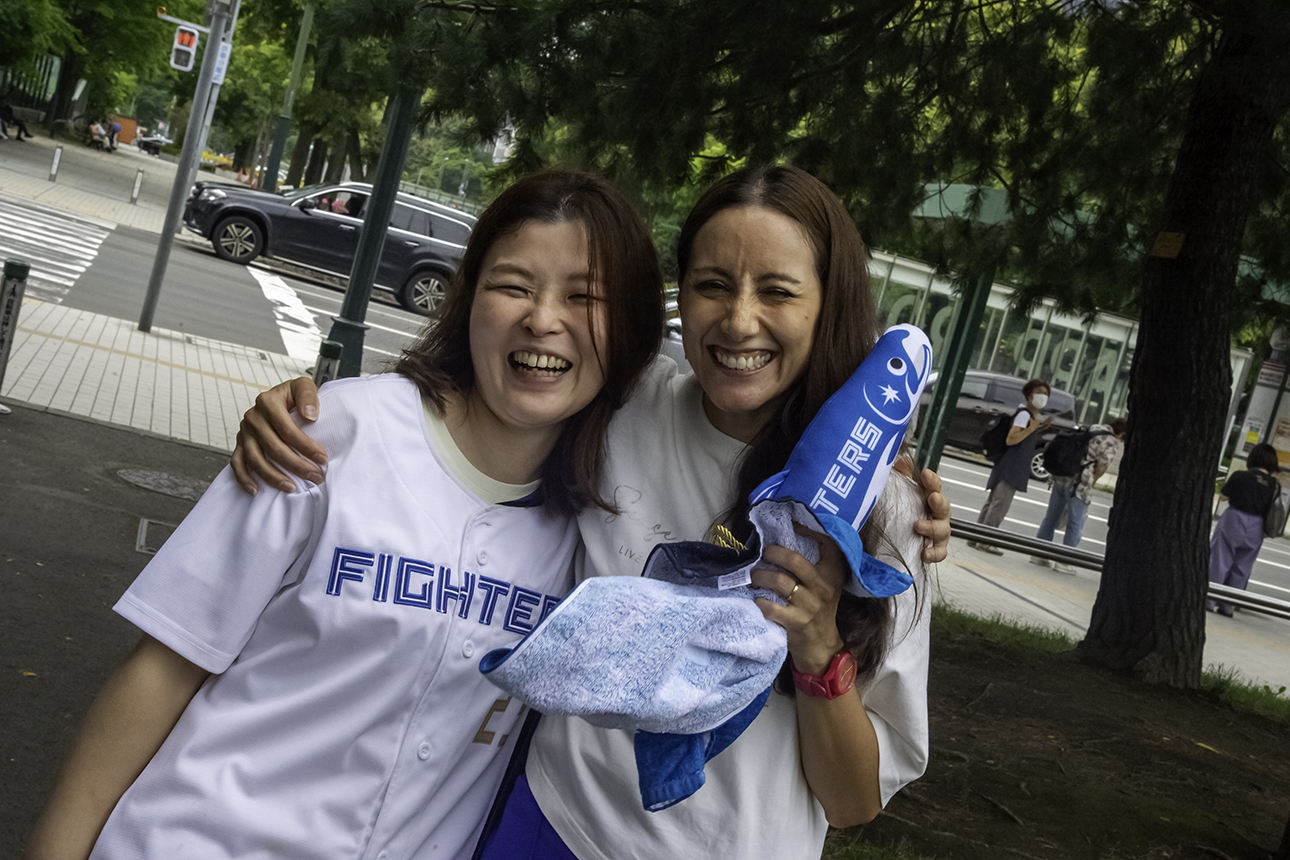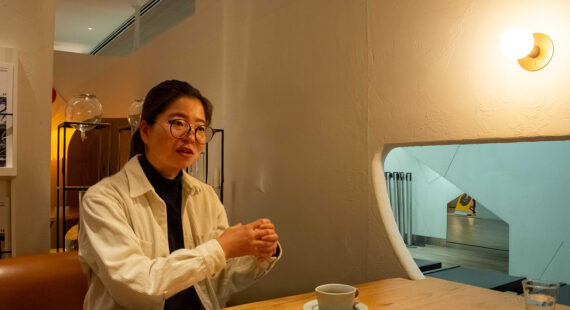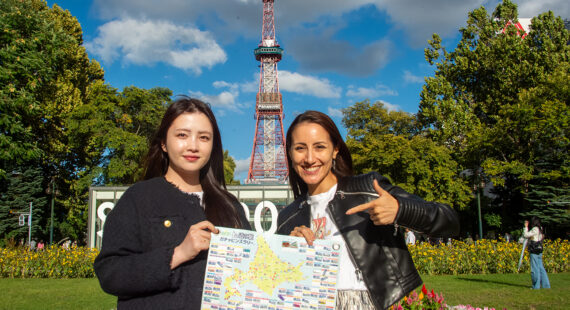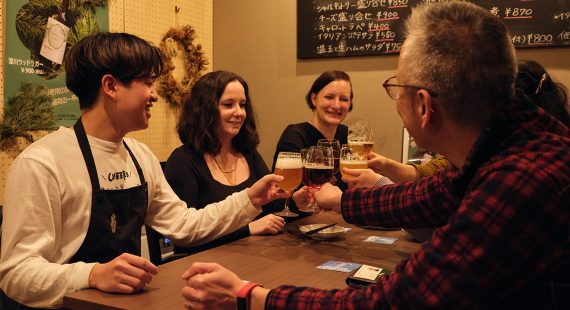(Written by Isis Berns)
Welcome to our brand-new series, “Meet the Travel Consultants”! I’m Isis Berns (a local Hokkaido media personality), and in the coming months, I’ll be sitting down with the incredible local experts at Hokkaido Treasure Island Travel. These are the people who live and breathe this magnificent island, the passionate individuals who transform a standard vacation into a journey of a lifetime. One by one, we’ll delve into their personal stories, uncovering their favorite hidden spots, must-try foods, and unique passions to help craft a custom trip to Hokkaido that is exclusively yours. Whether you’re dreaming of a niche-centric adventure, such as a Baseball Tour, or a serene nature escape blended with cultural immersion, our deep-rooted local connections unlock experiences that feel truly exclusive, the kind you simply can’t stumble upon solo. Hokkaido is calling—let us help you answer!
Table of Contents:
Part 1: The Making of a Baseball Fan
– From Ohtani’s Roots to Your Next Grand Adventure
– Meet Miwa: A Hokkaido Story Forged by Baseball
– The Middle School Matchmaker: How Math and English Led to Baseball
– A Manager’s Life: The Untold Story of High School Baseball in Japan
Part 2: A Journey Out and a Calling Home
– The Kansai Experience and the Ferocity of the Hanshin Tigers
– Around the World and Back Again: A Traveler’s Perspective on Home
– The Birth of a Hokkaido Home Team
Part 3: The Heart of Hokkaido Baseball – The Hokkaido Nippon Ham Fighters
– A Philosophy of Growth: Why the Fighters Are Different
– The Cradle of Legends: Darvish and the Two-Way Dream of Ohtani
– Interviewer’s Side-Story: My Own Connection to Hokkaido’s Open Spirit
– The “Shinjo Effect”: How One Man Reignited a Hokkaido Fanbase
– A Full-Time Fan is Born: Miwa’s Miracle at the Ballpark
Part 4: Your Ultimate Baseball Tour Itinerary
– The Crown Jewel: ES CON FIELD HOKKAIDO
– The Ultimate “Baseball x Food” Experience
– Beyond the Game: Year-Round Fun at F VILLAGE
– The VIP Treatment: An Exclusive BTS (Behind the Scenes) Tour Experience
– Joining the Oendan: How to Cheer With the Locals
Part 5: The Deeper Connection
– From Ballpark to Dream Job: Miwa’s Path to Guiding
– Rediscovering Home: A Hokkaido Native’s Perspective
– The Passion of the North: Finding Community in the Stands
Conclusion: The Enduring Spirit of Hokkaido
Part 1: The Making of a Baseball Fan
From Ohtani’s Roots to Your Next Grand Adventure
Major League Baseball has been profoundly and forever changed by a wave of Japanese legends. We’ve been captivated by the sublime grace of Ichiro Suzuki, the fierce precision of Yu Darvish, and of course, the once-in-a-century, history-rewriting talent of the phenomenal Shohei Ohtani. Their incredible skill, unwavering discipline, and palpable passion for the game have captured the hearts of fans across the globe. But what if I told you that to truly understand the soul of Japanese baseball, to witness the very environment that forges these titans, you need to travel to Hokkaido?
This vast, northernmost island of Japan is so much more than a postcard of stunning landscapes and a paradise for food lovers. It’s a crucible, a place where underdogs are nurtured into legends. It is the home of the team that patiently cultivated the talents of both Darvish and Ohtani. It is, most remarkably, where a forward-thinking organization took a monumental chance on a two-way superstar when every other team in the country said it was impossible. If you genuinely love the game of baseball, your next great trip awaits you in Sapporo, and we have the perfect travel guide to unlock its deepest secrets for you. Her name is Miwa Chiyokubo.
Meet Miwa: A Hokkaido Story Forged by Baseball

Our journey into the heart of Hokkaido baseball begins with one of our most passionate and knowledgeable travel consultants, Miwa Chiyokubo. To understand her unique approach to crafting the perfect Hokkaido tour, you first have to understand her story, a narrative that is inextricably linked with the crack of the bat and the roar of the crowd.
Miwa was born and raised in Kushiro, a city on the eastern coast of Hokkaido. It’s a place renowned for its sprawling wetlands, stunning sunsets, and deep connection to nature. In her childhood, however, there was no local professional baseball team to root for. The Nippon Ham Fighters had not yet moved to the island. As a result, the only games broadcast on television were those of the distant Yomiuri Giants from Tokyo.
“When I was a kid, my grandpa was a Giants fan and watched their games every day,” Miwa recalls with a smile. “If they lost, he would get really angry, and I could tell what happened that day by reading the newspaper.” This was her first, ambient exposure to the sport—a background hum of familial passion.
Her personal interest didn’t truly spark until a friend at school introduced her to a different side of the game. “The trigger was that my friend said a baseball manga was interesting,” she explains. It wasn’t a fictional story, but a four-panel comic that featured the actual, real-life players of the Giants as characters. “I was a bit interested because there was a cute character among the players,” she admits with a laugh.
It was this relatable, character-driven gateway that drew her in. She started watching the Giants games with her father, looking for the player from the manga. “From there, I became a little more interested. Gradually, I started to remember the rules of baseball and began to watch it through manga.” It was an unconventional education in the sport, but a deeply effective one. It taught her that baseball was as much about the personalities and stories of the players as it was about the final score.
The Middle School Matchmaker: How Math and English Led to Baseball
Miwa’s burgeoning interest blossomed into a full-blown passion in middle school, thanks to a clever and somewhat eccentric homeroom teacher in Kushiro. This teacher noticed a unique educational opportunity in the classroom’s social dynamics.
“I was somehow already good at English back then… but I was awful at math,” Miwa states. On the other hand, “the baseball club members were all really good at math”. The teacher saw a perfect symbiosis. “So, the teacher intentionally placed a lot of baseball club members next to me,” she says. The purpose was clear. “Yes, to help me learn math.”
The arrangement was mutually beneficial. “Since I was better at English, and they struggled with it, we combined our strengths and helped each other out”. But amidst the tutoring sessions, another subject dominated their conversations. “We talked about baseball the whole time”. Surrounded by members of the baseball club, she was fully immersed in the daily discussions, the post-game analyses, and the shared excitement of the sport. This experience solidified her next goal: “I wanted to be a manager of the baseball club when I went to high school”.
A Manager’s Life: The Untold Story of High School Baseball in Japan
And that’s precisely what she did. Upon entering high school, Miwa became the team manager, a role that is often misunderstood or has no direct equivalent in Western high school sports. It is a position of incredible responsibility, dedication, and hard work that goes far beyond simple administrative tasks. As Miwa puts it, it’s broadly described as doing chores, and she was the backbone of the team’s daily operations.
Her duties were relentless and anything but glamorous. She was responsible for the team’s gear and laundry, a monumental task for a group of athletes competing in the harsh conditions of Hokkaido. “When you go on an expedition, the team ends up getting their uniforms all muddy in the rain, and then I have to run the washing machine about three times to bring them back clean for the game the next day.” She was the one who filled the water coo. She she was the one tasked with “wiping down smelly helmets.”
But her role extended onto the field as well. During games, she served as the official scorekeeper and often acted as the stadium announcer, calling out the players’ numbers and names. During practice, she would be out on the field, picking up balls and assisting with drills. In a testament to the limited budgets of high school teams, she even stitched up worn-out baseballs by hand because the team couldn’t afford new ones. “We didn’t have any money for that,” she recalls. “I kept sewing the balls by hand with a needle.”
It sounds like a scene pulled directly from a coming-of-age anime, but this was her reality. It was a life of dirt, sweat, and total dedication to the team, which she saw not just as a group of friends, but as a family. This experience provided her with an incredibly intimate and profound understanding of the game—not just the rules, but the sacrifice, the teamwork, and the sheer grit it takes to play. It’s a passion that has never left her, a passion she now channels into designing the most authentic and immersive Hokkaido travel experiences for fellow fans. It’s not just a game; it’s a way of life.
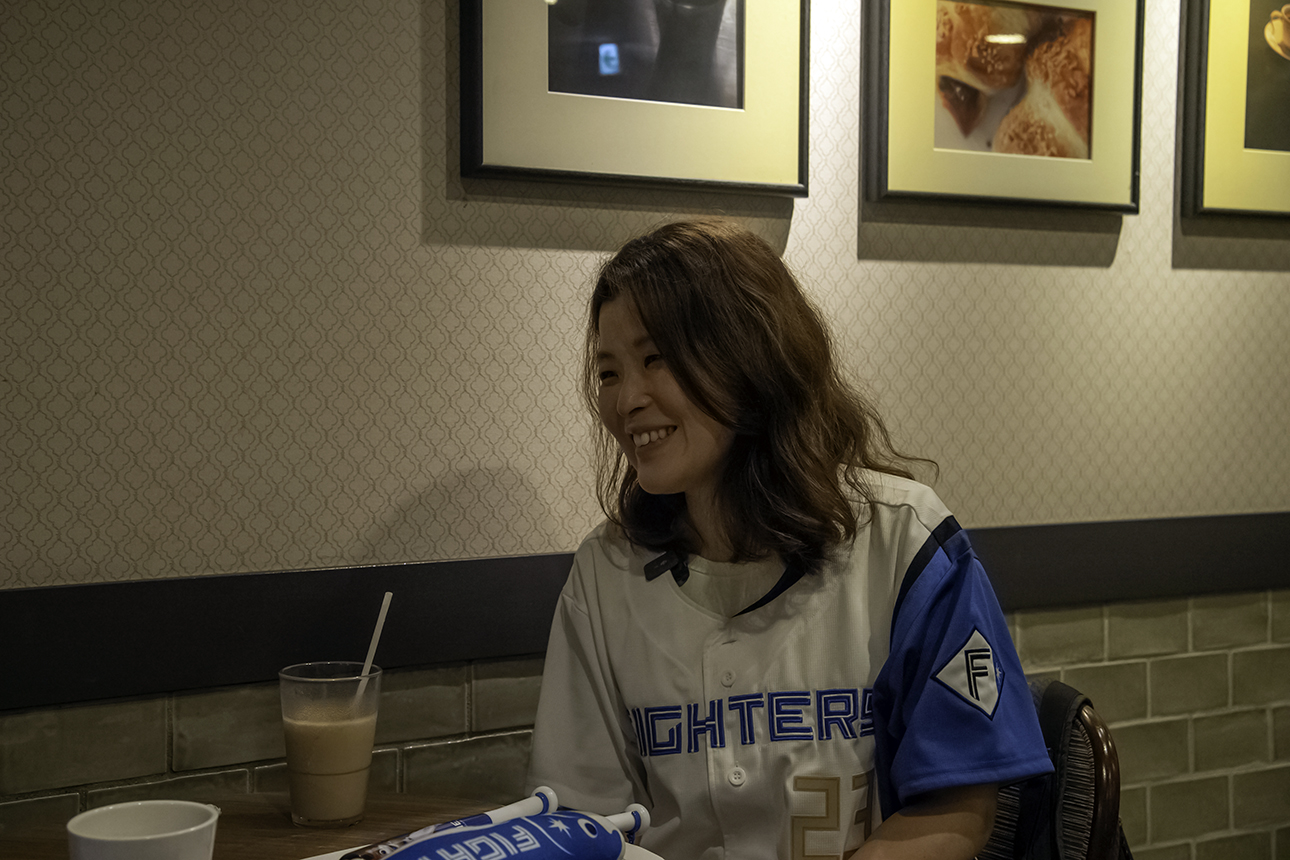
Part 2: A Journey Out and a Calling Home
The Kansai Experience and the Ferocity of the Hanshin Tigers
Like many young people growing up in a more rural part of Japan, Miwa felt the pull of the big city. After graduating high school, she initially dreamed of attending a university in Yokohama to be close to her favorite team at the time, the Yokohama BayStars. When that didn’t pan out, she headed to Kyoto for university, drawn by its rich history and beautiful temples.
Life in the Kansai region (which includes Kyoto, Osaka, and Kobe) exposed her to a completely different side of Japanese culture and baseball fandom. “In Kansai, many people are Hanshin Tigers fans,” she says. The passion of the Nishinomiya, Hyōgo Prefecture, Hanshin Tigers’ baseball team supporters was on a completely different level from anything she had ever experienced.
“It’s amazing. The passion!” Miwa exclaims. “Back then, if they lost, they would really throw their megaphones and go home… sometimes drag the opponent’s mascot character on the ground. That’s not typically something a Japanese person would express. It’s extremely intense, almost like a brawl.” She describes the atmosphere on the train after a game against their rivals, the Giants, as being “really tense.” For any North American sports fan, she notes the powerful parallel to the rivalries in a winter sport. “In Canada, it’s ice hockey, right? Because ice hockey completely turns into a fight on the way home. They’re vocal about it too.”
The victories were just as extreme. “When we win, it’s such a joy that we honk our car horns and shout ‘Yay!’ in the streets until midnight.” This fiery, expressive fandom was a contrast to the typically more reserved and gentle nature of the people she grew up with in Hokkaido.
Around the World and Back Again: A Traveler’s Perspective on Home
Miwa’s journey didn’t stop in Kansai. After university, she worked in Tokyo, Nagoya, and Osaka. But a desire for a different kind of adventure was growing. “Because I wanted to go on a working holiday at that time, I quit my job at 30 and went to Canada.” After her Canadian experience, she did another working holiday in the UK before finally returning to Japan.
She didn’t return to her hometown of Kushiro, however. Her mother, a nurse, worked in a small clinic in Akan, a beautiful hot spring town known for its stunning caldera lake and Ainu culture. Thinking it would be a great place to use her English skills with tourists, Miwa decided to join her, working in a hotel for about a year. Still seeking new environments, she later moved to Niseko, the world-famous ski resort town bustling with international visitors.
These experiences as an extensive traveler, both within Japan and abroad, gave Miwa a unique perspective. She had seen the concrete jungles of Tokyo and Osaka, the historic streets of Kyoto, and the global villages of Canada and the UK. She understood what it meant to be a tourist and what it meant to seek authentic experiences. Yet, through it all, the quiet call of her home island, Hokkaido, was always present.
The Birth of a Hokkaido Home Team
There’s a poignant irony in the timing of Miwa’s life journey. The very year she left Hokkaido to begin her university studies in Kyoto, 2004, was the year the Nippon Ham Fighters relocated from Tokyo and officially became Hokkaido’s team. “When I left for university, we just missed each other perfectly,” she says. “So I didn’t know anything since I left Hokkaido. I couldn’t get much information about how the Hokkaido team was doing.”
While she was away experiencing the world, a new baseball culture was taking root back home. By the time she returned, the Fighters were no longer a transplanted team from Tokyo; they were deeply woven into the fabric of Hokkaido life. Read on to find out how deep it is!
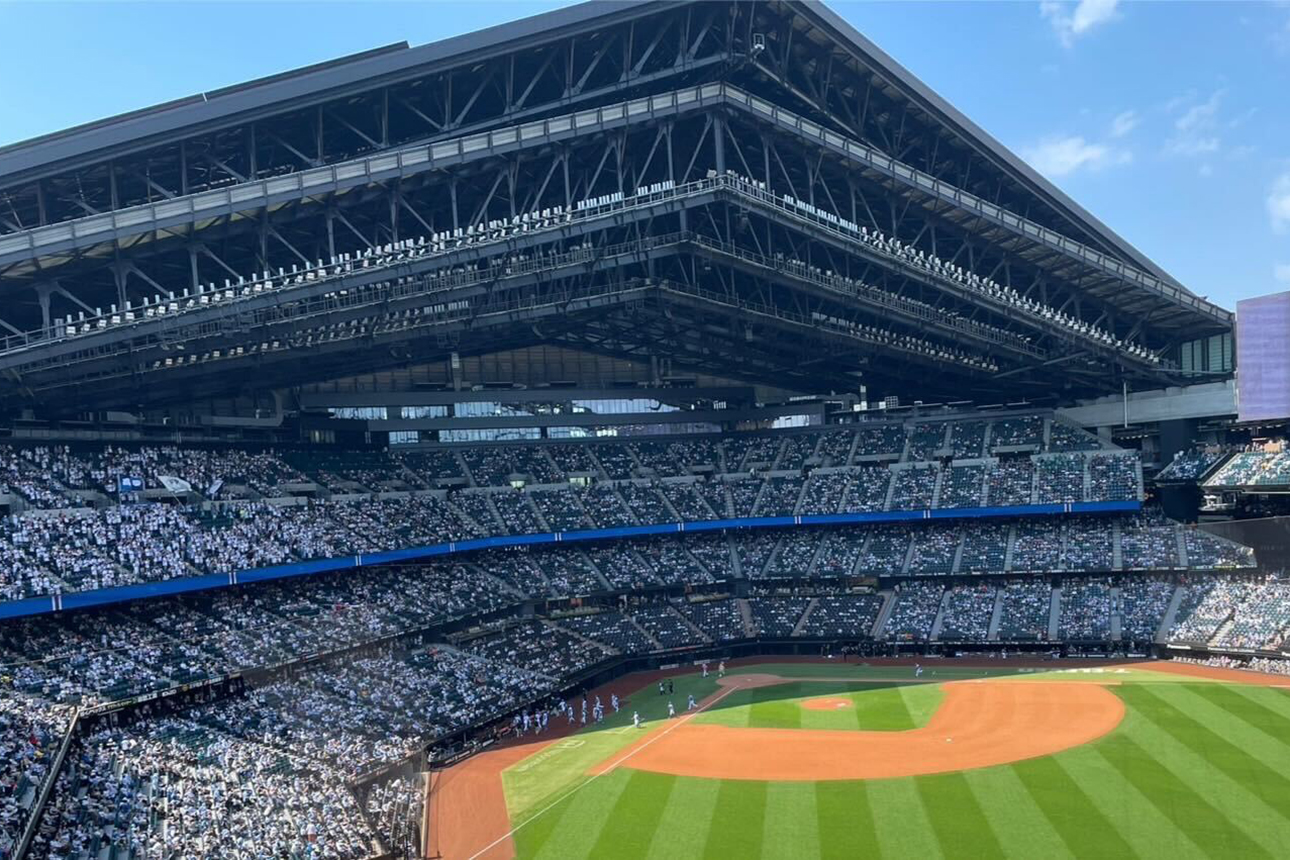
Part 3: The Heart of Hokkaido Baseball – The Nippon Ham Fighters
A Philosophy of Growth: Why the Fighters Are Different
When Miwa returned to settle in Hokkaido, she began to notice how much the landscape had changed, both literally and culturally. The Fighters were everywhere. “When I came back, I saw that the Fighters’ players were in posters all around the city, in the subways, even in TV commercials. Local Hokkaido shows, such as “Dosanko Wide,” also featured the Fighters’ players in detail, which quickly grew their fan base. I could tell that the team had really taken root.”
She soon learned that what makes the Hokkaido Nippon Ham Fighters so special isn’t just their presence, but their philosophy. In the world of Nippon Professional Baseball, where wealthy corporations often “buy” championships by acquiring established players from other teams, the Fighters operate differently. “The team in Hokkaido doesn’t have the money, so they can’t do that,” Miwa explains. Instead, they built their success on a different model: scouting and patiently developing young, raw talent. “I think that’s better for the team. They’re good at training players, rather than just throwing them in right after high school graduation.”
Their approach is long-term. “This year, there are kids who graduated high school 3 or 4 years prior, finally making it to the first team, onto the field, and suddenly performing amazingly,” she points out. The team’s ethos is clear: “Come after practicing hard for two years and gaining confidence.” This patient-nurturing environment has proven to be a fertile ground for greatness.
The Cradle of Legends: Darvish and the Two-Way Dream of Ohtani
This unique philosophy is precisely what allowed the Fighters to change the course of modern baseball history. They were the team that cultivated the immense talent of Yu Darvish, helping him win numerous awards, including the prestigious Sawamura Award, Japan’s equivalent of the Cy Young. “It’s really impressive to keep doing something consistently for many years,” Miwa notes, highlighting the foundation the Fighters helped him build.
But their most legendary and audacious move was their belief in a high school phenomenon, now an internationally renowned household name: Shohei Ohtani. At the time of his first Japanese baseball draft, Ohtani had a radical, unprecedented demand: he wanted to be a two-way player, both a pitcher and a hitter. Every other team in Japan rejected the idea.
“There aren’t any other professional baseball teams that would allow that,” Miwa emphasizes. “Basically, if you do something like that, you’ll hurt your body or your career will be shorter, so they won’t let you do it.” Faced with this universal rejection, Ohtani was prepared to forgo a career in Japan and head straight to the major leagues after high school.
But one team was different. The Fighters in Hokkaido, with their culture of innovation and openness to new ideas, made him a promise. “If I remember correctly, Mr. Kuriyama, [the Nippon Ham team manager at the time], said they would let him be a two-way player.” They took the chance no one else would. They believed in his dream. The rest, as they say, is history. Many MLB fans today are unaware of this crucial part of his origin story. “Everyone knows he’s from Japan. But not many know he had played in Hokkaido’s Nippon Ham Fighters,” Miwa says. But for the people here on this northernmost island of Japan, “Hokkaido honors their careers. Can we boast about it?”
“It absolutely is,” I agreed, “It’s a local pride to have had those baseball stars in our Hokkaido baseball fields. It’s an honor to know we live and breathe in the same Hokkaido fresh air.” We both agreed. Even in Sapporo’s subway lines, you can see posters of the Fighters team with bold letters in English: “HOKKAIDO LOVE” and “HOKKAIDO PRIDE.” Plan your next baseball tour to see it yourself!
Interviewer’s Side-Story: My Own Connection to Hokkaido’s Open Spirit
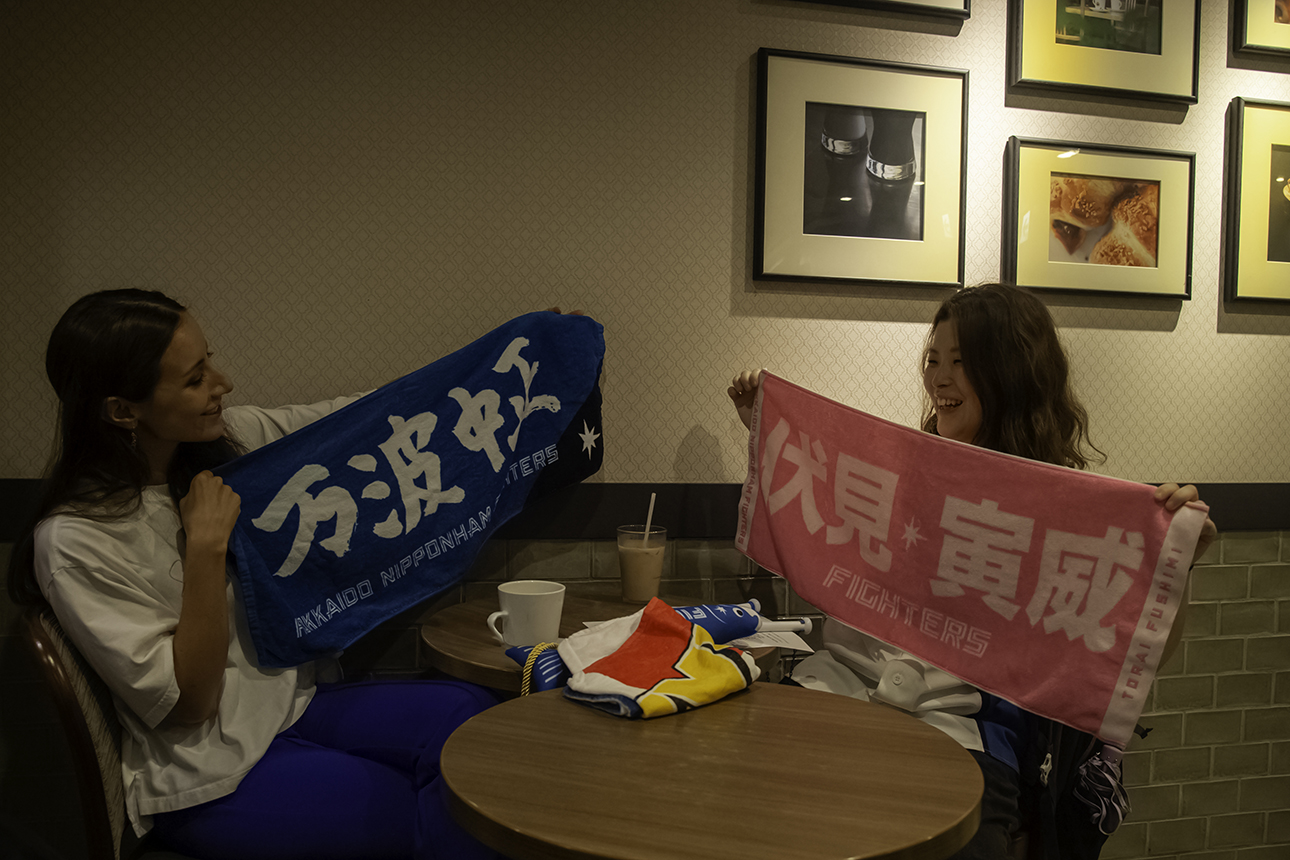
Hearing Miwa talk about the Fighters’ open-mindedness resonates deeply with my own personal experience. This spirit of welcome and acceptance is pure Hokkaido. I felt it firsthand when I was 15 years old and wanted to do a homestay in Japan. It was during the global SARS outbreak, and understandable fear led families across the country to say “no” to a student coming from Toronto. All of them, that is, except one. A family in Kamifurano, Hokkaido, said yes. They welcomed me with open arms, and that kindness is something I have never forgotten. That’s also why I was so determined to return here after university to make Hokkaido my home.
This island has a unique history. It was settled by pioneers from all over Japan—people seeking a new life, a fresh start, and the freedom to build new dreams. This pioneering ethos, this willingness to embrace the new and the unconventional, is deeply ingrained in the very soul of Hokkaido. It’s why a baseball team here, far from the traditional centers of power (like Kyoto, Osaka, or Tokyo), was willing to bet on a kid who wanted to do the impossible.
The “Shinjo Effect”: How One Man Reignited a Hokkaido Fanbase
For Miwa, falling in love with her home team in Hokkaido was a gradual process. A major catalyst was the hiring of a new manager: the legendary, flamboyant, and utterly unique Tsuyoshi “BIGBOSS” Shinjo. When the news broke that he would be taking over, the entire island of Hokkaido buzzed with excitement.
“Isn’t Shinjo-san an incredibly extraordinary person?” Miwa asks. “He does unbelievable things. Even in baseball, he suddenly starts doing things that are absolutely not in the theory.” Shinjo was a former superstar player known for his flashy style, incredible talent, and magnetic personality. As a manager, he brought that same energy, promising to change the team and follow through on his words. “So obviously, my hope and high expectations rose high from then on.”
That hope was palpable. Shinjo’s arrival marked a turning point for the team’s atmosphere. Miwa notes that in the years before, when the Fighters were weaker, the passion in the stands was more subdued. “Nobody was wearing these kinds of clothes,” she says, referring to the team uniforms. “It felt a bit lonely.” But Shinjo’s charisma and the team’s subsequent improvement transformed the fan experience into the vibrant, energetic celebration it is today.
A Full-Time Fan is Born: Miwa’s Miracle at the Ballpark
The final piece of the puzzle for Miwa, the moment that turned her from a casual observer into a devoted, uniform-wearing fan, came during a single, unforgettable game.
“I happened to get tickets to a pretty good seat right behind home base,” she begins, “and it was actually [catcher Torai] Fushimi-kun’s birthday. I had no idea at all.” Fushimi was a player, originally Hokkaido-born, who had excelled in the championship-winning team, the Orix Buffaloes. But that year, he had decided to transfer to the lowest-ranking team, the Hokkaido Nippon Ham Fighters. That was a move that surprised many, but it showed his commitment to his home, Hokkaido.
At the Fighters fan store in the stadium, Miwa saw a special corner celebrating his birthday and, on a whim, decided to buy a towel to cheer for him. It turned out to be a fateful decision. The game was a nail-biter. “That day was a walk-off win,” she says, her voice still filled with excitement. In the bottom of the ninth inning, the team staged a stunning comeback. And the hero of the hour? “The person who hit that walk-off win was Fushimi-kun.”
“So, he had an amazing performance on his birthday,” she concludes. “I felt the wave of emotion roar in the stands, and that’s when I became a fan.” For Miwa, that was it. “The moment you see something that, your heart races, and you feel like you’ve witnessed a miracle right in front of you.” It is this deep, emotional connection to the team and its players that Miwa now wears proudly on her sleeve—or rather, on her back, in the form of her No. 23 Fushimi jersey.
I had a similar experience watching Fighters games: when Mannami, a right-handed thrower, unleashes a precise throw from deep right field to home plate with incredible speed, it took my breath away. With that throw, he could nail one runner after another. Likewise, I recall a powerful home run by Reyes, the towering 1.96-meter, 120-kg Dominican nicknamed ‘La Mole’ for his rock-solid strength reminiscent of a Marvel superhero. After seeing their superhuman baseball powers, I headed straight for the Fighters fan shop to buy their towels! Why not create your own experiences like this with a personal Sapporo travel guide?
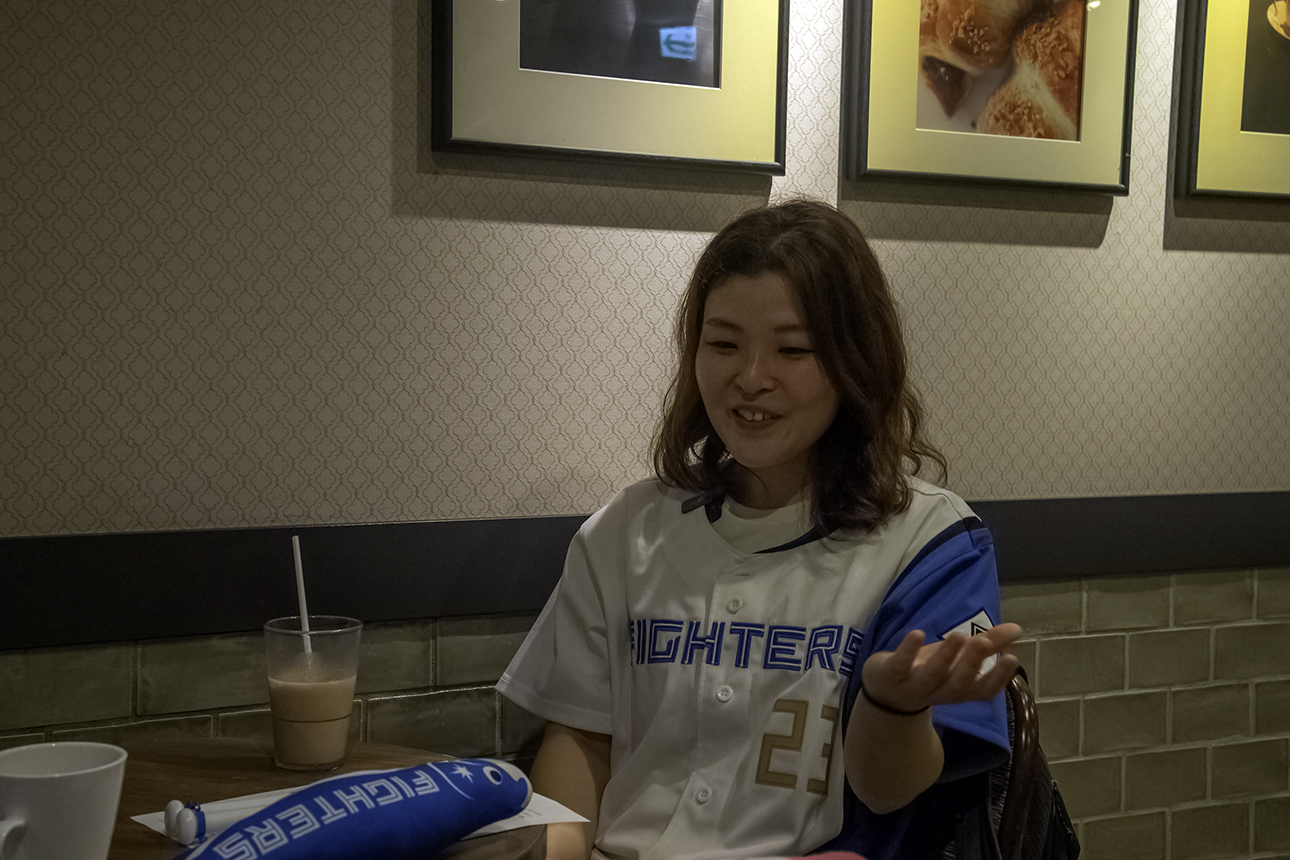
Part 4: Your Ultimate Baseball Tour Itinerary
The Crown Jewel: ES CON FIELD HOKKAIDO
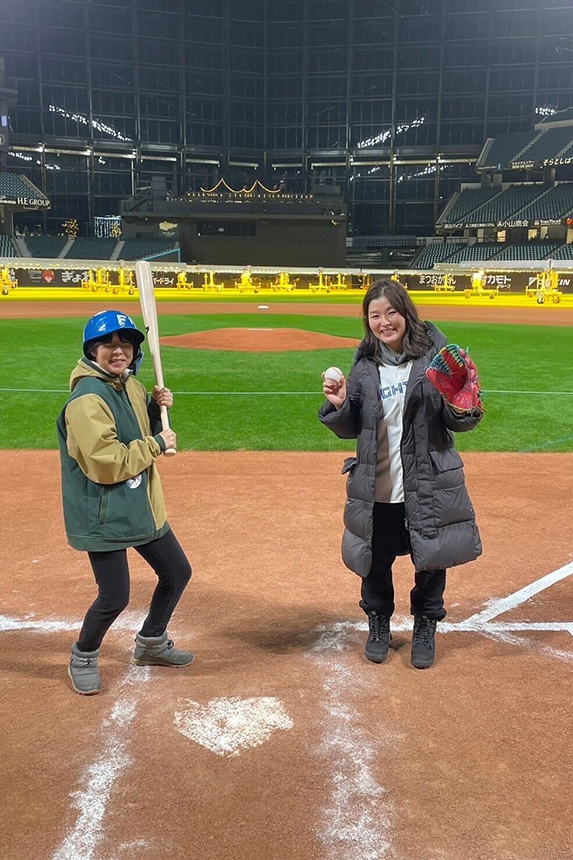
The heart of any modern Hokkaido baseball tour is, without question, the spectacular ES CON FIELD HOKKAIDO. Opened in March 2023, this is not just a ballpark; it is a revolutionary entertainment destination. When asked if it’s a must-visit spot for tourists, Miwa’s answer is emphatic: “Of course”.
“The reason is that everyone, even those who don’t understand baseball or aren’t interested, say it’s fun,” she explains. It’s not just a baseball park, it’s a whole “F VILLAGE” community, designed to cater to all ages and interests. “There are facilities for children (an indoor playground, a mini train driving around the field, a mini baseball field outside for kids to try batting or catching, and much more), plenty of events and restaurants for people of all ages to enjoy.”
The atmosphere is electric and welcoming, turning even casual observers into excited participants. When I first took my children (aged 5 and 7 at the time) to watch a Fighters game, they didn’t know any baseball rules. “After just one game, they begged me to go again! Even though they didn’t understand any of the rules of baseball,” I shared. “They were excited and loved the: ‘it’s like a party!’ they said.” The passion at ES CON FIELD is infectious. “My daughter loved it so much that for her birthday, she said, ‘I want to spend it at a Fighters game!’ So last year, her wish came true. We attended a Hokkaido Nippon Ham Fighters game to celebrate her special day. She wore the uniform, the fox ears, ate the ‘Transform into Ftan Bear Wagyu Hamburger’ and all.” Ftan, by the way, is the name of an adorable blue bear, the official mascot of Hokkaido Ballpark F Village. “My daughter loved every minute of it.”
This is the magic of ES CON FIELD. It’s a place that transcends sports, creating a day-long adventure that your entire family will remember. A well-planned itinerary is key to unlocking all it has to offer. Miwa, your travel consultant, is eager to help you!
The Ultimate “Baseball x Food” Experience
One of the stadium’s biggest draws is its incredible culinary scene. Forget the standard North American ballpark fare of just hot dogs and peanuts (don’t get me wrong, I love hot dogs and they sell them here too!). But ES CON FIELD is a gastronomic showcase of the best food from all over Hokkaido! “Gourmet food, right? First of all, it’s high-quality and delicious,” Miwa says, contrasting it with the junk food found at other stadiums.
There are counters where sushi chefs prepare fresh nigiri right in front of you. You can enjoy freshly grilled Okonomiyaki (aka a “Japanese pizza,” made with flour, eggs, and cabbage, and grilled on a teppan (griddle) with Okonomi, which means any ingredients you like). Even a full yakiniku (grilled meat) meal. If there’s a famous Hokkaido meal, you’ll probably find it available for sale at the field. The options are astounding and ever-changing, making every visit a new culinary adventure. Leave it to your Sapporo travel guide to pinpoint what’s in season and what the most popular dish is at the time of your travels.
Miwa has her personal favorites to pencil in to your baseball tour: “What I really like is going to a beef tongue restaurant,” she says. It’s a famous shop located in the Shin-Chitose Airport area, with a branch inside the stadium. She also highlights the special gourmet items produced by the Figthers players themselves, like a popular seafood rice bowl from pitcher Hiromi Ito, who comes from a family of fishermen in the Hokkaido town of Shikabe.
And to drink? While she’s not a heavy drinker, Miwa recommends the craft beer from “Sora to Shiba by Yona Yona Ale,” the craft beer brewery located right inside the stadium where she used to work. And you can’t miss the uniquely Japanese experience of the “beer girls” and “beer boys,” who run through the stands with draft beer backpacks. Ordering is simple: “Just raise your hand and make eye contact,” Miwa advises. It’s a quintessential part of the fun and a service you won’t find at ballparks overseas.
Beyond the Game: Year-Round Fun at F VILLAGE
What makes ES CON FIELD and the surrounding F VILLAGE a truly exceptional destination is that the fun doesn’t stop when the baseball season ends. This is a year-round attraction, perfect for any Hokkaido tour, even in the middle of winter.
“Many tourists visit ES CON FIELD for the snow,” Miwa notes, confirming that the facility is open, though there may be a few closure days in January. The village offers a perfect “first snow” experience. “They start their winter activities around November,” she says, making it an option for early snow–seekers. “If there’s no snow yet, they provide artificial snow, and it’s amazing because you can even try skiing there.” She shares a story of clients with young children who had a blast sledding at F VILLAGE in late November.
F Village isn’t just for baseball tours! The activities are diverse and exciting. I personally experienced a thrilling ride on a rafting boat pulled by a snowmobile across a field of powder snow right in front of the baseball field. Last year, they also added an ice skating rink for the winter, which complements their summer stand-up paddleboarding activity. This year-round accessibility means that a visit to this Sapporo-area landmark can be a highlight of your trip, no matter the season.
The VIP Treatment: An Exclusive BTS (Behind the Scenes) Tour Experience
This is where a planned tour with an expert like Miwa elevates your trip from great to unforgettable. A game ticket is just the beginning; the real magic lies in the exclusive, behind-the-scenes experiences.
“After an amazing match, they offer stadium tours where you can see the locker room and more,” Miwa reveals, a rare opportunity for fans. “When I joined the tour myself, I saw Fushimi-kun’s uniform being washed and some pens left after the game. It felt very real. Like, ‘He was just here!’” On select days, there are also events where the field opens up after the game, allowing fans to walk on the very ground where their heroes just played. “For fans, being able to stand on the ground where the match was held is a precious experience.”
These are often separately ticketed, optional add-ons that can be difficult to navigate and book from overseas. This is the value of a custom tour; Miwa can seamlessly integrate these “plus option” experiences into your itinerary.
Her local knowledge extends beyond the stadium walls. A truly dedicated fan’s tour could include a visit to “an Udon shop (thick, white, chewy Japanese noodles made from wheat flour, water, and salt), run by the father of a Fighters player” or “a bar run by a former Fighters player in Sapporo.” These are local haunts where you’re likely to find yourself among fellow fans, sharing stories and celebrating the team.
Joining the Oendan: How to Cheer With the Locals
The most immersive and unforgettable experience for any visitor is to dive right into the oendan, or organized cheering section in the stands. This is a world away from the spontaneous cheering and booing common in Western sports. It is a vibrant, coordinated, and overwhelmingly positive spectacle of support.
First rule: you have to stand. “If you don’t stand, you can’t be in those seats, that’s the rule,” Miwa says with a laugh. The primary instrument of cheering is not your hands, but a pair of small, plastic megaphones or bat-shaped batons that fans clap together. Each player has their own unique cheer song, a tradition that creates a deep connection between the fans and the team.
Don’t worry if you don’t speak Japanese! “The cheer song is in Japanese, but the lyrics will appear on the big screen,” Miwa assures. You can easily follow along with simple chants like “Oi! Oi!” Then there’s the famous “Kitsune Dance,” a viral sensation where the entire stadium dances along to the Ylvis song “The Fox (What Does the Fox Say?).” While the official cheer squad is a dedicated group of volunteers, they welcome everyone to join in the fun. Imitating the person next to you is the fastest way to learn and, as Miwa suggests, a fantastic way to make new friends. This is the cultural immersion that many travelers seek—a chance to share a moment of pure joy with locals.
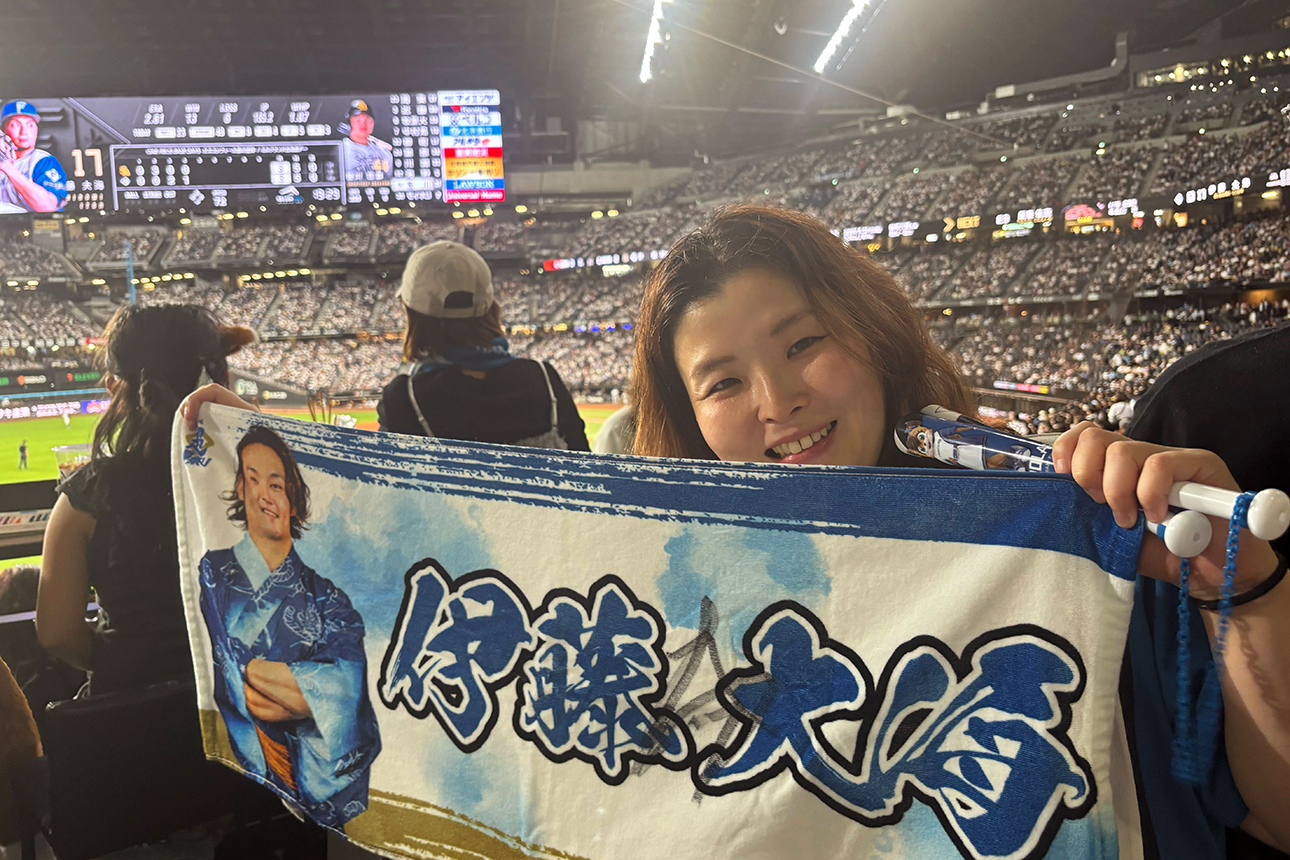
Part 5: The Deeper Connection
From Ballpark to Dream Job: Miwa’s Homerun
Miwa’s journey to becoming a Hokkaido travel consultant was as serendipitous as her love for baseball. After the initial excitement of helping open ES CON FIELD, the reality of the work set in. The hours were grueling. “The ‘nighter’ games end late at night, around 11 o’clock. Then I’d be there again at 8 a.m. for the day match the next day,” she recounts. The seasonal nature of the job was also a challenge. “Especially after the baseball season ends, I’d end up being really bored. The difference was so significant that I knew it’d be difficult to keep going.”
She decided to make a change, moving to a hotel job in Niseko while she figured out her next steps. It was there, while casually browsing job sites, that opportunity found her. “I received a message directly from President Suzuki,” she says, still sounding surprised. The president of Hokkaido Treasure Island Travel had seen her resume and personally reached out. “That’s when I first learned about this company, and after researching it, I thought it looked really fun.”
Though she had never worked for a travel agency, her background in service at hotels and restaurants was a perfect fit. More importantly, the job offered a chance to use her English and share her deep love for her homeland. “I was surprised by the amazing welcome. What a wonderful group of people,” she says of the team. Now, she channels all her experiences—from her childhood in Kushiro to her global travels and her profound love for baseball—into creating unforgettable journeys for visitors to Hokkaido.
Rediscovering Home: A Hokkaido Native’s Perspective
I asked Miwa, “What is it about Hokkaido that truly sets it apart from the rest of Japan and the world?” For Miwa, leaving and then returning gave her the clarity to see what makes it so special. Growing up in Kushiro, she took the extraordinary for granted. “I was born and raised in Kushiro, and I thought it was normal,” she says. “Every morning, I would ride my bike through the Kushiro-Shitsugen National Park wetlands at 5 a.m. with the sunrise. I’d often see wild deer or foxes. One time, a fox even stole my shoes! I thought that kind of thing was normal. Red-crowned Cranes were just part of the local scenery.” No way, Miwa! Those elegant birds are designated as a Special Natural Monument by the Japanese government due to their endangered status and cultural importance!
As a teenager, Miwa felt constrained by the close-knit community where everyone knew everyone’s business. “That’s why after graduating high school, I wanted to go to the city instead of the countryside.”
Her time in Japan’s major cities was a culture shock. “It was crowded with people and full of buildings. All manufactured things,” she recalls. The overwhelming “concrete jungle” of urban Japan made her see her home, Hokkaido, in a new light.
“I see now that Hokkaido is on a different scale,” she reflects. “How the stars are incredibly visible, or how you can see the horizon… I didn’t realize that being able to see the horizon is something rare and special.” This deep appreciation for Hokkaido’s vast, open spaces and natural beauty is something she loves to share with visitors who are also looking to escape busy city life. Miwa’s not only a Sapporo travel guide; she can design a tour that combines the excitement of baseball at ES CON FIELD with a trip to her home region of Kushiro to experience that same awe-inspiring nature.
The Passion of the North: Finding Community in the Stands
Ultimately, the most powerful experience a traveler can have is a human connection. Miwa believes the best place to find the true spirit of Hokkaido’s people is at a Hokkaido Nippon Ham Fighters game.
“People from Hokkaido are quite shy,” she observes, comparing them to the more outgoing people of Osaka. “But when it comes to cheering for the Fighters, everyone gets really excited.” At the ballpark, the usual reserve melts away, replaced by a collective, unbridled joy. “You can feel the enthusiasm of Hokkaido people.”
“I went yesterday, and the game’s end was amazing. When the Fighters scored, everyone cheered and stood up to hug each other, even strangers!” This is the magic. In a culture that values privacy and maintaining distance, the ballpark becomes a place of spontaneous community and shared emotion. It’s the feeling of belonging that every traveler hopes to find.
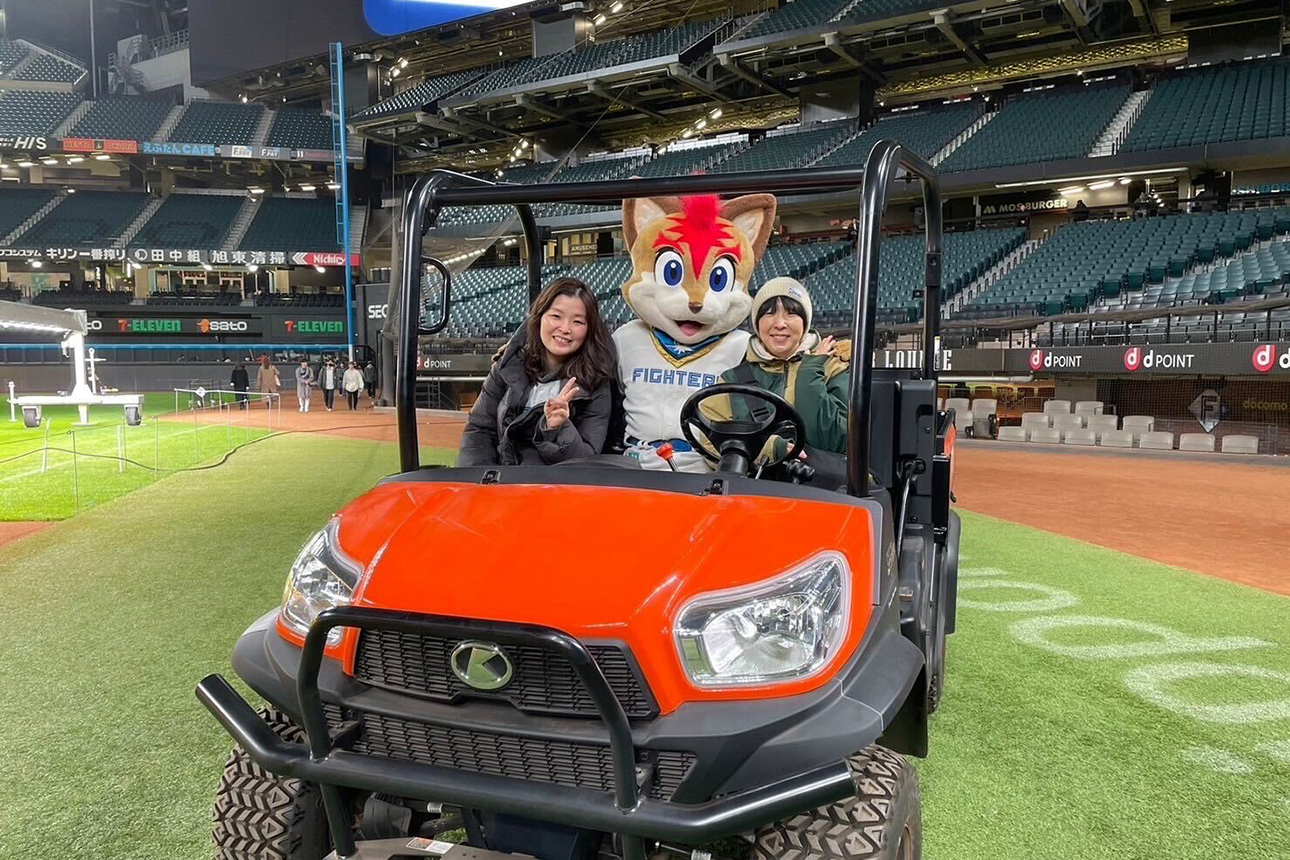
Conclusion: The Enduring Spirit of Hokkaido
The story of Hokkaido is one of resilience and creation. It is a land built by the hands of pioneers from across Japan who came seeking a new beginning. “My grandparents were also able to pioneer,” Miwa shares. “They started from a place with absolutely nothing, went through a lot of struggles, and have come to where they are now”.
This pioneering spirit lives on in the Hokkaido Nippon Ham Fighters. They, too, started from a place with almost no local history, a team without a deep-rooted home, and built something extraordinary. They created a culture that dared to be different, a place where a once-in-a-generation talent like Shohei Ohtani could be nurtured and his impossible dream could be realized.
When you visit ES CON FIELD, you can see paintings of Ohtani and Darvish hanging like modern icons—a testament to this incredible legacy. You can feel the spirit of a player who, after becoming a global superstar, sent a baseball glove to every single elementary school in Japan, ensuring the next generation has a chance to dream.
This is the story of Hokkaido. It is a story of nature, of passion, of community, and of daring to believe in the extraordinary.
Come and meet Miwa. Let her be your Sapporo travel guide on a personalized tour through this incredible island. Let her share the local secrets, the hidden gems, and the roaring passion of a Hokkaido Nippon Ham Fighters game. Come and experience the natural beauty, the culinary delights, and the living miracle of baseball in a way you never imagined. Your ultimate Hokkaido travel itinerary is waiting to be written.
